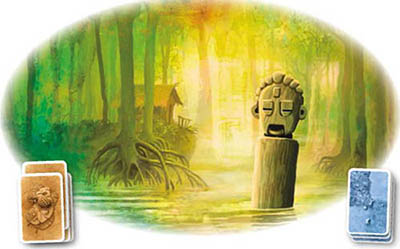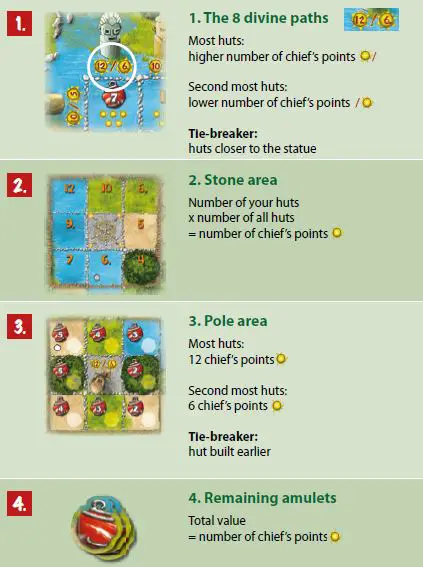
It's not only the clear water and the abundant vegetation that make Mangrovia appealing and unspoiled. From time immemorial, your tribe has managed to live in harmony with nature, following its customs and traditions. But not everything is immortal.
The days of your wise chief are gradually nearing an end. Nowit is time to find a good successor. In order to live up to the model of the old chief, you build huts along the divine paths and bring precious amulets to sacred locations. Your foresight and the persuasive power of your deeds might make you the new chief soon.
Components

- 1 Gameboard
- 32 landscape cards
- 53 valuable cards
- 1 Boat
- 2 Birds of Paradise
- 1 Starting Player Talisman
- 40 Amulets
- 1 Amulet Bag
- 50 Huts
- 10 Pillars
- 10 Bowls
- 8 Pole Tiles
- 16 Stone Area Tiles
Object of the Game
In order to earn chief's points  , you collect amulets and build huts:
, you collect amulets and build huts:
- on the eight divine paths
- in the stone area
- in the pole area.
There are four vertical and four horizontal divine paths. Each path begins next to or below a God's statue and consists of all landscape spaces of one column or row.

Amulets also give you chief's points Q at the end of the game. Besides this, amulets are required to build huts at certain locations. Amulets in the bag:
If you earn more chief's points  than any of the other players, you win and become the new chief.
than any of the other players, you win and become the new chief.
Setup

- In the five-player game, each player gets 8 huts and 1 bowl.
- In the four-player game, each player gets 9 huts and 1 bowl.
- In the two- or three-player game, each player gets 10 huts and 2 bowls.
- In the three-player game, you place a hut of an unused color on each of the 3 landscape spaces with a gray hut symbol
 . In the two-player game, you place such a hut on each space with a gray hut symbol
. In the two-player game, you place such a hut on each space with a gray hut symbol  (3) as well as on each space with a white hut symbol
(3) as well as on each space with a white hut symbol  (7).
(7). - In the two-player game, put the tile with the value 2 below the neutral hut in the pole area. Consequently, now tile value 3 is lying on top of the pile.
In addition, you block the last ritual site (landings 6/7) with a neutral bowl. Those landings are ignored completely during the entire game.
1. Huts, Bowls, and Chief's Pillars
You place your chief's pillar on space 0 of the chief's track a nd get huts and bowls in your color (see text-box bottom left).
The remaining huts, bowls and chief's pillars are not needed.

2. Game Cards and Starting Player Talisman
Determine a starting player. He puts the talisman in front of him. Distribute the starting cards:The starting player gets the two cards with the number 1 and takes them into his hand.
His left neighbor gets the cards with the number 2.The other players get, in turn and in clockwise order, the cards with the numbers 3, 4 and 5. Return any unused starting cards to the box.
Shuffle the remaining valuables and put them as a face-down draw pile next to the gameboard. Reveal four of them and lay them out next to one another.
 display valuables |
Shuffle the landscape cards. Each player gets 2 of them and takes them into his hand. Put the remaining landscape cards as a face-down draw pile next to the gameboard. Reveal three landscape cards and lay them out next to one another.
 display landscape cards |
3. Boat and Birds of Paradise

Place the boat on the marked boat space above the archipelago.
Put one bird of paradise on the (dark green) mangrove space and the other bird of paradise on the (blue) water space of the oracle rock.
4. Amulets and Amulet Pillars
Stack the 5 amulets with the value 1 face upon the repository space below the amulet track. Put all the other amulets into the amulet bag at the beginning of the game; have this bag accessible next to the gameboard.
Each player places the amulet pillar of his color in the left column next to space Oof the amulet track. The remaining amulet pillars are not needed.
5. Pole Tiles
Sort the pole tiles by number values, in ascending order from the 2 on top to the 9 at the bottom, and put them as a face-up pile on the small island space next to the pole area.
(Exception: two-player game, see text-box to the left)
Game Play
Each game round consists of 3 phases, which you execute always in the same order:
- Placing bowls - choosing actions
- Moving the boat - carrying out actions
- Preparing the next game round.

Phase 1: Placing Bowls - Choosing Actions
The starting player begins. The other players follow in clockwise order.
On your turn, you place your own bowl on any unoccupied ritual site of the archipelago. The symbols on the twelve landings show you what action(s) a player is allowed to carry out when the boat reaches that bowl.

In the two- and three-player game, each player, in turn, then also places his second bowl on a free ritual site. In this case, the starting player may not place his first bowl on the first ritual site of the archipelago (landings 1/12). However, he may place his second bowl there, provided this site is still unoccupied.

Phase 2: Moving The Boat - Carrying Out Actions
The boat heads to the landings 1 to 12, one after another, around the archipelago. If there is a bowl on the associated ritual site, the boat stops. The owner of this bowl carries out the action indicated on the landing.
You may never change the indicated order of actions. However, you may forego (parts of) actions if you wish. If there is no bowl at the ritual site, you move the boat ahead immediately.
How to carry out the actions
How to build huts:
 Example 3: Right now, you can build only on water spaces and sand spaces. |
A hut may be built only on an unoccupied landscape space. The landscape of this space must be marked by one of the two birds of paradise on the oracle rock.
How to place birds of paradise:
Put the birds of paradise on two different landscape spaces of the oracle rock. You may also leave one or both birds where they are.
How to draw cards:
Cards are drawn only from the draw piles and the face-up cards displayed next to them - never from other players!.

You may not change the specified order in which the cards must be drawn face down or face up. For each single card, you can choose freely whether you draw a valuable or a landscape card.
When drawing two face-down cards, you may look at the first one before you draw the next one. Face-up cards in both displays (valuables and landscapes) that were drawn are not replaced immediately but only in phase 3!
How to collect amulets:

With your amulet pillar on the amulet track, you mark the number of huts you have on the red-encircled amulet spaces. The more huts you have built on amulet spaces, the more amulets you are allowed to collect. Lay down the amulets you have collected face-down in front of you.


Building One Hut..
To build one hut, you have to (from your card hand)...
pay the exact amount of valuables or amulets that is indicated on the space in question.
If you are notable to pay the exact amount, you may not build a hut on the applicable space. You may not pay a higher amount.
If the space indicates valuables as the means of currency, you may not pay with amulets (and vice versa).
give up a landscape card that corresponds to the landscape of the respective space.
If you have built a hut on a space that shows chief's points
, you immediately move your chief's pillar on the chief's track the applicable number of spaces forward.

If you have built a hut in the pole area, you place the topmost pole tile from the pile underneath this hut and immediately move your chief's pillar ahead on the chief's track the number of spaces that corresponds to the value of the pole tile.

Please note: The center square of both the stone area and the pole area are not considered building spaces.That means you may not build huts on these squares.

Building Two Huts..
If you build two huts (which is allowed only from landing #10), you erect two huts, one after another, on two different spaces. You have to pay the exact amount for each of them individually. All rules apply as previously described in "Building one hut.."..

Building Double Huts..
If you build a double hut (which is allowed only from landing #9), you pay twice the amount of valuables or amulets plus two corresponding landscape cards.
If you have built a double hut on a space that shows chief's points
, you immediately move your chief's pillar double the number of steps forward.
Please note: Double huts may not be built in the following areas:

- In the entire stone area
- In the entire pole area
- On all 10 amulet spaces
Already-built huts cannot be "upgraded" to a double hut.
Double-landscape Spaces...

There are two double-landscape spaces on the gameboard, each of them consisting of two landscapes. If you build a hut on such a space, the landscape card you pay with has to correspond to one of the landscapes (of the space in question). This type of landscape must be occupied by one of the birds on the oracle rock.
If you build a double hut on a double-landscape space, you may choose to pay with landscape cards of one or both landscapes (of the space in question).

However, here too, you are not allowed to pay with landscape cards of a type that is not occupied by a bird on the oracle rock.
After Building a Hut:
Once valuables and landscape cards have been used, they are collected on separate discard piles. Sort out the starting cards and put them back into the game box. When a draw pile has been depleted, shuffle the corresponding discard pile and use it as the new draw pile.
Put the amulets aside that you have used for building huts. Only if the bag is empty you put all the amulets that you have put aside (so far) back into the bag.

Phase 3: Preparing the Next Game Round
-
The player who has occupied the first ritual site of the archipelago (between landings 1 and 12) with his bowl in this round takes the talisman and thus becomes the starting player of the next game round.

Important:
If the first ritual site of the archipelago is unoccupied, the starting player (of the round that just ended) passes the talisman to the neighbor on his right, who then becomes the starting player of the next round.
He has to move the birds of paradise to the two unoccupied landscape spaces of the oracle rock.

-
Take your bowls back from the ritual sites and put the boat back on the starting boat space.
-
Refill the display of valuables to 4 cards, using cards from the draw pile.
-
Refill the display of landscape cards to 3 cards, using cards from the draw pile.

Final Scoring
When one player has built his last hut, the current game round is still completed. Now players score additional chief's points.
The 8 Divine Paths
Players check who has built the most huts on each of the four vertical and four horizontal divine paths. Double huts count as two huts.
The numbers in front of the statues indicate how many chief's points the players get for having built the most and second most huts on the respective path. In case of a tie (same number of huts), the player whose hut is closer to the statue of this path wins.
In the two- and three-player game, huts of neutral color are included in the count (also to resolve a tie). That means: If you are behind the (fictional) "neutral" player in terms of the number of huts on a path, you'll also be ranked behind him in the scoring.
The Stone Area
Calculate your chief's points in the stone area as follows: Multiply the number of your huts in the stone area by the total number of all huts in the stone area.
The Pole Area
If you have built the most huts in the pole area, you score 12 chief's points. The player with the second most huts in this area scores 6 chief's points.
In case of a tie (same number of huts), the winner of the tie is the player who has built his first hut in the pole area earlier than the other players involved in the tie.
This is easy to find out by checking the pole tiles under the huts: Huts on pole tiles with a lower value were built earlier than those on higher-value pole tiles.
In the two-player game, the neutral hut is included in the count (also to resolve a tie). That means: If you are behind the (fictional) neutral player in terms of the number of huts in the pole area, you'll also be ranked behind him in the scoring.
Remaining Amulets
For each amulet a player owns, he scores chief's points equal to the amulet value.
Example: Final Scoring:

Ending Of The Game
After all players have moved their chief's pillars to mark their chief's points on the chief's track, it becomes clear to whom the Gods are particularly inclined: The player who has earned the most chief's points  becomes the winner and thus the future tribe leader.
becomes the winner and thus the future tribe leader.
In case of a tie, the player (among the tied players) who has the highest total value of amulets at the end of the game wins.
There can be more than one winner.
Game Variant - The Stowe Area Tiles
All rules of the basic game apply. Additionally, eight stone area tiles come into play. Distribute eight of them face-up randomly onto the eight spaces of the stone area.The remaining eight stone area tiles are put back into the box.
In the two- and three-player game, there are only seven stone area tiles placed, since no tile is positioned on the space with the hut of a "neutral" color.
Special rules for the course of the game: If you build a hut on a space of the stone area, you receive the stone area tile lying there.
You keep any tile that shows a God's statue for the rest of the game. If you are involved in a tie on a divine path for which you own the tile with the corresponding God's statue, the tie is resolved in your favor.
Different from the basic game, the distance from his huts to the God's statue of this path doesn't play a role for the owner of this tile.
You may use tiles with other motifs anytime during your own turn, as follows (discard them after use):
This tile counts as a valuable with the value 3.
This tile counts as an amulet with the value 2.
"Landscape wild card". If you give up this tile, you may build a hut on any landscape space-no matter where the birds of paradise are sitting.
Other Possible Variants:
If you want, you can also deliberately use just the (eight) stone area tiles showing God's statues. Or, the other way around, it is also possible to deliberately take these tiles out of the game and use the eight "godless" tiles instead.
Continue Reading





